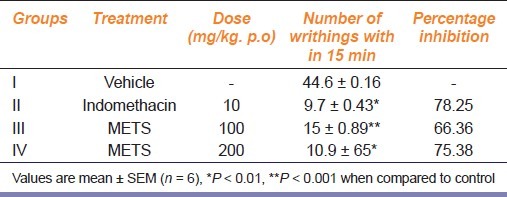Sir,
Pain and inflammation remains one of the world's major health problems.[1] Excessive inflammatory response has damaging effects, such as septic shock, which can lead to multiple organ dysfunction syndrome and death. Novel potent analgesic and anti-inflammatory drugs without considerable side effects from the natural sources are under evaluation. Tecoma stans (Bignoniaceae) is an ornamental plant found throughout India. It is not a toxic plant because it is used in Latin America as a remedy for diabetes and for feeding cattle and goats in Mexico.[2] Leaves of the T. stans contain the alkaloids tecomine and tecostamine, which are potent hypoglycemic agents when given intravenously. Anthranilic acid is responsible for the antidiabetic activity; roots are powerful diuretic and vermifuge.[3] In the present investigation the methanolic crude extract of flowers of T. stans was tested for anti-nociceptive and anti-inflammatory activities.
The flowers of T. stans were collected in the month of May 2011 from Namakkal District, Tamil Nadu, India and authenticated by Joint Director of Botanical Survey of India, Coimbatore. Flower petals were dried in shade, powdered and 100 g of the dried powder was extracted with 2 l of methanol by hot Soxhlet apparatus. The solvent was removed under reduced pressure and controlled temperature by using rotary flash evaporator to get the sticky mass of extract (yield 8.9% w/w).
Anti-nociceptive activity was assessed using acetic acid induced writhing test. Swiss albino mice of both sexes weighing between 25 and 30 g were divided in to four groups of six animals each. The first group served as the control and received vehicle (CMC 2.0%w/v in normal saline), second group received the standard drug indomethacin (10 mg/kg, p.o.). Third and fourth groups received methanolic extract of T. stans at 100 and 200 mg/kg p.o respectively. Anti-nociceptive activity was expressed as the percentage inhibition of abdominal constrictions between the four groups.
Anti-inflammatory activity was assessed using Carrageenan induced rat paw edema method. Male Sprague-Dawley rats weighing 200-250 g were used. Here rats were divided in to four groups of six animals each. Group I animals received vehicle (CMC 2.0% w/v in normal saline). Group II animals received indomethacin (10 mg/kg b. w., p. o.). Groups III and IV animals received methanolic extract of T. stans flowers (100 and 200 mg/kg b. w., p. o., respectively). The suspension was prepared by using CMC 2.0% w/v in normal saline. The extract was administered 1 h before carrageenan injection (0.1 ml of 1.0% in to sub plantar region of right hind paw in all groups.[4] Inflammation was calculated by measuring paw volume initially and at 1, 2 and 3 h after carrageenan injection, using plethysmograph.
Data obtained by both methods were analyzed by one way ANOVA. Methanolic extract of T. stans flowers at the dose of 100 and 200 mg/kg produced significant anti-nociceptive activity by suppressing the acetic acid induced writhing in mice in a dose dependent manner [Table 1]. This was comparable to the standard drug (indomethacin 10 mg/kg, p.o.).
Table 1.
Effect of methanolic extract of T. stans flowers extracts on acetic acid (0.6%) induced writhing test in mice

When compared with the control, the extract and standard drug significantly reduced the paw edema 3 h after carrageenan injection. After 3 h of the carrageenan injection, the extract at the dose of 100 and 200 mg/kg body weight showed 75 and 79% inhibition of the paw volume respectively, whereas the standard drug (indomethacin 10 mg/kgb.w./p.o.) showed 81% inhibition of the paw volume. The anti-inflammatory effect of the extract and the reference drug increased with time.
The preliminary phytochemical screening of extract showed the presence of tannin, flavonoids, phenol, alkaloids, steroids, triterpenes, anthraquinones, saponins etc. Flavonoids were thought to possess an important role in anti nociceptive and anti-inflammatory activity primarily by inhibiting the prostaglandin synthesis. Most of the NSAIDs have well-balanced anti-inflammatory and ulcerogenic properties, which are considered to be due to PG synthetase inhibitor activity.[5]
The methanolic extract of flower of T. stans showed marked anti-nociceptive activity. The inhibitory effect could be due to the inhibition of prostaglandin pathway. Inhibitory effect in carrageenan induced inflammation could be due to inhibition of the enzyme cyclooxygenase and subsequent inhibition of prostaglandin synthesis. Significant inhibition of paw edema in the early hours of study by extract could be possibly due to inhibition of histamine and/or serotonin.
Further phytochemical and pharmacodynemic studies are being carried out to isolate the active compounds responsible for the anti-nociceptive and anti-inflammatory activity and to establish the mechanism of this action of the plant extract.
References
- 1.Li RW, Myers SP, Leach DN, Lin GD, Leach G. A cross-cultural study: Anti-inflammatory activity of Australian and Chinese plants. J Ethnopharmacol. 2003;85:25–32. doi: 10.1016/s0378-8741(02)00336-7. [DOI] [PubMed] [Google Scholar]
- 2.Susano HR. Especies arboreas forestales susceptibles de aprovecharse como forraje. Ciencia Forestal. 1981;6:31–9. [Google Scholar]
- 3.Khare CP. Indian medicinal plants and illustrated dictionary. New Delhi: Springer Science Publishers; 2007. [Google Scholar]
- 4.Winter CA, Porter CC. Effect of alteration in side chain upon anti-inflammatory and liver glycogen activities of hydrocortisone ester. J Am Pharm Assoc Am Pharm Assoc (Baltim) 1957;46:515–9. doi: 10.1002/jps.3030460902. [DOI] [PubMed] [Google Scholar]
- 5.Mule SN, Ghadge RV, Chopade AR, Bagul BA, Patil SB, Naikwade NS. Evaluation of anti-nociceptive and anti-inflammatory activity of leaves of Gynandropsis pentaphylla. J Herbal Med Toxicol. 2008;2:41–4. [Google Scholar]


